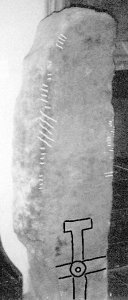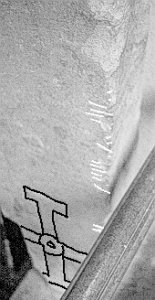According to Macalister, CIIC, the stone was "discovered in the foundation of the chancel of the old church of Gowran, when it was rebuilt to serve as the parish church. The inscription was first published by G.V. du Noyer in 1849. About 1897 (thus according to Macalister, JRSAI 27, 1897, 221) it was removed from the ruins and replaced near the pulpit of the church by Canon Hewson. By the time of Macalister, CIIC it was erected near the altar within the church.
Size according to Brash, OIM 281: 4'10" x 16" x 9"-11"
Size according to Macalister, CIIC: 4'11" x 1'3" x 0'11 3/4"
Published illustrations:
- Brash, OIM, pl. XXXIX.
- Macalister, CIIC 37 (draft).
According to Brash, JRSAI 16, 1884, 129 no drawing was published before he published his treatise.
Left angle:
åäåãòñâîìã......êè....âîíâææð
IERACO S Q G
IERACOS MAQI G
"The inscription is much injured by spawls knocked off the angle". - "We have evidence of the presence of the word MAQI on the head of the stone; the M is absent, we have the next to letters perfect, and one digit of the I, the rest lost by injury".
Right angle:
ìææææîíãïäîìã........
D QOMUCO
DEGO MAQO MUCOI
The inscription on this angle "appears to have been a distinct one, and not a continuation of that on the left. - We have .. evidence of the presence of the keyword MAQO, a form found on several monuments". - The name IERACOS of the "first inscription .. is of the same type as Iarnon, Irereo, Iarulea, Ann. 4 Mas. The Gaulish form is Iricus .. Gruter, 842,8 .. Aug.Taur.; we also find this name on Samian red ware, in the form of Irici (Cel.Rom.Sax. p. 470)." - The proposed reading of the right angle "of course is partially conjectural .. The name Dego has been found in legends from Dunlo {197, Coolmagort: DEGOS} .. and St. Olan's well {122: Mount Rivers}, and one of the Drumlohan find .. gives us `Deago Maqi Mucoi'" {281}. - The same type of cross as the one on the present stone "is to be found on the Dromkeare stone" {233}. It is "quite evident" that this is "the appropriation .. to Christian uses" because it must have been added when there was no more knowledge of Ogham, given that it was carved in at the bottom of the stone.
MAQI MUCOI | LASICAREIGNI
The cross must surely be older than the inscription, because its ends were removed when the edge was prepared for inscribing. LASICAREIGNI "might have been the name Laserian".
Reading Macalister, Academy 29.12.1894 (quoted in JRSAI 27, 1897, 221):
IQADIERACIAS MAQI...D...QO MUCOI
The starting letters -IQ are "obscure"; ERACIAS is a "form of" ERCIAS.
MaqIERACiASMAQI ... | DiMAQAMUCOi ...
The name to which the DI- belongs has most probably to be restored as BLADI or BODI, not DEGO or DALO, because we would expect the B-strokes to be recognizable. For BLADI as a genitive beside nominative MAQA cp. Latin anakolutha such as TALORI .. FILIUS in the inscription from Pant y Polion, Caerm. {361: Cynwyl Gaeo}. - Of Maqi, only the B-part of the M-stroke and one H-stroke are visible. The H-stroke has to be ignored if a reading Q is intended, the other ones are missing. The restitution is probable because of MAQIERCIAS appearing in Roovesmore {125} and Coumeenoole {178} and MAQQIERCCIA on the Burnham stone {175}; -A- is an "auxiliary vowel". A restoration as HIERACIAS would be improbable. - The cross must have been engraved later then the Ogham. - Ferguson's reading presupposes an antithetic ordering of the letters S and C; he should rather have read LASICAREGNI.
ERACIAS
The reading is quoted because of the "auxiliary vowel" A not present in other occurrences of the name, cf. Ballintaggart I {155}.
MAQI-ERACIAS MAQI DIMAQA MUCO[I ....
The cross has been engraved on the "original base of the inscribed face". 1M, 1A, 1Q3,4 and 2I3,4,5 were "chipped away" as well as 2MA (on top); 2A of DIMAQA was "chipped off"; it has "nothing to do with MAQ or MAQI"! ERACIAS has a svabharakti [read: svarabhakti] vowel. There is no G "at the top of the right-hand angle" as indicated by Barry in his "monograph in JRSAI".
MAQI ERACIAS [MA]QI DIMAQ[A] MUCO[I ...
The cross was engraved later than the inscription. The A can be restored with certainty. The name of a pagan deity was removed.
Reading Gippert (1978):
 Dexter angle, up:
Dexter angle, up:
I] ERAC[IA]S [
å]äåãòñâîìå[äâ]êè[
â]ââââæââââïïïïïâëëëëââ[ ]çççç[
 Sinister edge, up:
Sinister edge, up:
D[ ]M(AQA M)[U](C)O[
ìææï(âîíâï)[ä](îì)ã[
ëëæææææï(âëëëëëâïââ[â](ëëëë)ââ[
The top of the stone must be verified again.
Additional literature:
- Academy, 29.12. 1894: Macal;
- JRSAI Ser. V/5, 350: Barry;
- JRSAI 12, 1872, 223, 232 (Prim / Ferguson); 437 (Brash);
- PRIA 7, 1849, 252: G.V. du Noyer.
Last changes of this record: 23.04.97
Copyright Jost Gippert, Frankfurt a/M 1996. No parts of this document may be republished in any form without prior permission by the copyright holder.  Dexter angle, up:
Dexter angle, up: Sinister edge, up:
Sinister edge, up:
